The latest Microsoft MCSA 70-764 exam dumps is in pass4itsure.com. We have many years of exam experience,
all of our exam databases are updated throughout the year, and pass4itsure Microsoft exam experts will modify the content
at any time based on customer feedback. 100% Guarantee. Easily pass the Microsoft MCSA 70-764 Exam, please select
Pass4itsure 70-764 PDF or 70-764 VCE. Microsoft MCSA official Testing center has released the following
questions and answers: https://www.pass4itsure.com/70-764.html
[PDF] Free Microsoft MCSA 70-764 dumps download from Google Drive:
https://drive.google.com/open?id=1tIorh0jIgCtjseDYvUcvRopg6sXZ17fq
[PDF] Free Full Microsoft dumps download from Google Drive:
https://drive.google.com/open?id=1VBDzuasBbmByXUKyUaZejR3hFzTke722
Exam 70-764: Administering a SQL Database Infrastructure – Microsoft:
https://www.microsoft.com/en-us/learning/exam-70-764.aspx
Pass4itsure offers the latest Microsoft MCSA 70-764 practice test free of charge (30Q&As)
QUESTION 1
You have a database named DB1 that is configured to use the full recovery model. You have a full daily backup job that runs at 02:00. The job backs up data from DB1 to the file
B:\DB1.bak.
You need to restore the DB1 database to the point in time of May 25, 2016 at 02:23 and ensure that the database is functional and starts to accept connections.
Which Transact-SQL statement should you run?

A. Option A
B. Option B
C. Option C
D. Option D
Correct Answer: B
Explanation
QUESTION 2
You have a SQL Server instance on a server named Server1.
You need to recommend a solution to perform the following tasks every week:
Rebuild the indexes by using a new fill factor.
Run a custom T-SQL command.
Back up the databases.
What should you recommend?
More than one answer choice may achieve the goal. Select the BEST answer.
A. A trigger
B. An alert
C. A maintenance plan
D. Windows PowerShell
E. A system policy
Correct Answer: C
Explanation
Explanation/Reference:
Maintenance plans create a workflow of the tasks required to make sure that your database is optimized, regularly backed up, and free of inconsistencies.
Reference: Maintenance Plans
QUESTION 3
You have a customer who has several SQL Server 2012 database servers.
You are designing a data warehouse for the customer. The data warehouse will use columnstore indexes.
The customer identifies that the following must be supported for the column store indexes.
Data manipulation language (DML) statements
Nonclustered columnstore indexes
Clustered columnstore indexes
Partitioning
You need to identify which technology requires the customer to implement an SQL Server 2016 database.
What should you identify?
A. clustered columnstore indexes
B. nonclustered columnstore indexes
C. data manipulation language (DML) statements
D. partitioning
Correct Answer: A
Explanation
Explanation/Reference:
Explanation: SQL Server 2016 has the features of SQL Server 2012 plus updateable clustered columnstore indexes. This feature is required here as DML statements must be supported in the warehouse.
Reference: Columnstore Indexes Described
https://msdn.microsoft.com/en-us/library/gg492088(v=sql.120).aspx
QUESTION 4
Note: This question is part of a series of questions that use the same or similar answer choices. An answer choice may be correct for more than one question in the series. Each question is independent of the other questions in this series.
Information and details provided in a question apply only to that question.
You need to examine information about logins, CPU times, and Disk I/O on a particular database in Microsoft Azure.
What should you use?
A. Activity Monitor
B. Sp_who3
C. SQL Server Management Studio (SSMS) Object Explorer
D. SQL Server Data Collector
E. SQL Server Data Tools (SSDT)
F. SQL Server Configuration Manager
Correct Answer: A
Explanation
Explanation/Reference:
Activity Monitor displays information about SQL Server processes and how these processes affect the current instance of SQL Server. Activity Monitor is a tabbed document window with the following expandable and collapsible panes:
Overview, Active User Tasks, Resource Waits, Data File I/O, and Recent Expensive Queries.
The Activity User Tasks Pane shows information for active user connections to the instance, including the following column:
* Login: The SQL Server login name under which the session is currently executing.
The Recent Expensive Queries Pane shows information about the most expensive queries that have been run on the instance over the last 30 seconds, including the following column:
* CPU (ms/sec): The rate of CPU use by the query
References:https://technet.microsoft.com/en-us/library/cc879320(v=sql.105).aspx
QUESTION 5
You plan to create a database.The database will be used by a Microsoft .NET application for a special event that will last for two days.
During the event, data must be highly available.
After the event, the database will be deleted.
You need to recommend a solution to implement the database while minimizing costs. The solution must not affect any existing applications.
What should you recommend?
More than one answer choice may achieve the goal. Select the BEST answer.
A. SQL Server 2016 Enterprise
B. SQL Server 2016 Standard
C. SQL Azure
D. SQL Server 2016 Express with Advanced Services
Correct Answer: B
Explanation
Explanation/Reference:
Programmability (AMO, ADOMD.Net, OLEDB, XML/A, ASSL) supported by Standard and Enterprise editions only.
Reference: Features Supported by the Editions of SQL Server 2016
QUESTION 6
You are designing a monitoring application for a new SQL Server 2016 instance.
You need to recommend a solution to generate a report that displays the 10 most frequent wait types that occur for the instance.
What should you include in the recommendation?
More than one answer choice may achieve the goal. Select the BEST answer.
A. The SQL Server error log
B. The sys.dm_os_wait_stats dynamic management view
C. The DBCC SQLPERF(WAITSTATS) command
D. SQL Server Profiler
Correct Answer: B
Explanation
Explanation/Reference:
sys.dm_os_wait_stats
Returns information about all the waits encountered by threads that executed. You can use this aggregated view to diagnose performance issues with SQL Server and also with specific queries and batches.
Columns include:
waiting_tasks_count
Number of waits on this wait type. This counter is incremented at the start of each wait.
Reference:
sys.dm_db_wait_stats (Windows Azure SQL Database)
QUESTION 7
DRAG DROP
Note: This question is part of a series of questions that use the same scenario. For your convenience, the scenario is repeated in each question. Each question presents a different goal and answer choices, but the text of the scenario is
exactly the same in each question
in this series.
You have five servers that run Microsoft Windows 2012 R2. Each server hosts a Microsoft SQL Server instance. The topology for the environment is shown in the following diagram.
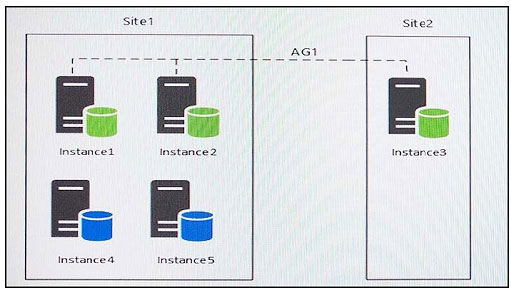
You have an Always On Availability group named AG1. The details for AG1 are shown in the following table.

Instance1 experiences heavy read-write traffic. The instance hosts a database named OperationsMain that is four terabytes (TB) in size. The database has multiple data files and filegroups. One of the filegroups is read_only and is half of the
total database size.
Instance4 and Instance5 are not part of AG1. Instance4 is engaged in heavy read-write I/O.
Instance5 hosts a database named StagedExternal. A nightly BULK INSERT process loads data into an empty table that has a rowstore clustered index and two nonclustered rowstore indexes.
You must minimize the growth of the StagedExternal database log file during the BULK INSERT operations and perform point-in-time recovery after the BULK INSERT transaction.
Changes made must not interrupt the log backup chain.
You plan to add a new instance named Instance6 to a datacenter that is geographically distant from Site1 and Site2. You must minimize latency between the nodes in AG1.
All databases use the full recovery model. All backups are written to the network location \\SQLBackup\. A separate process copies backups to an offsite location. You should minimize both the time required to restore the databases and the
space required to store backups. The recovery point objective (RPO) for each instance is shown in the following table.

Full backups of OperationsMain take longer than six hours to complete. All SQL Server backups use the keyword COMPRESSION.
You plan to deploy the following solutions to the environment. The solutions will access a database named DB1 that is part of AG1.
The wait statistics monitoring requirements for the instances are described in the following table.

You need to analyze the wait type and statistics for specific instanced in the environment.
Which object should you use to gather information about each instance? To answer, drag the appropriate objects to the correct instances. Each object may be used once, more than once, or not at all. You may need to drag the split bar
between panes or scroll to view content.
NOTE: Each correct selection is worth one point
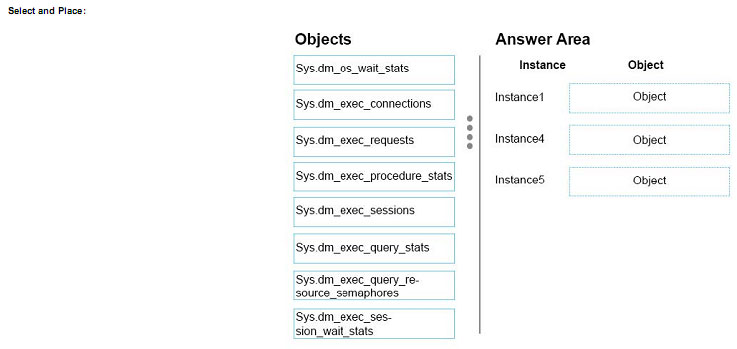
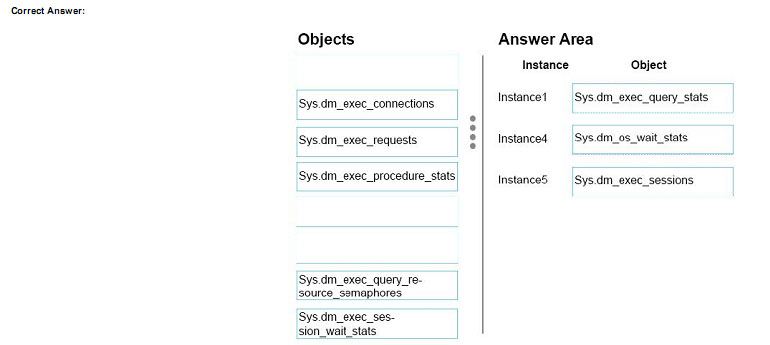
Explanation
Explanation/Reference:
QUESTION 8
HOTSPOT
You manage a Microsoft SQL Server environment. You have a database named salesOrders that includes a table named Table1.
Table1 becomes corrupt. You repair the table.
You need to verify that all the data in Table1 complies with the schema.
How should you complete the Transact-SQL code statement? To answer, select the appropriate Transact-SQL code segments in the dialog box in the answer area.
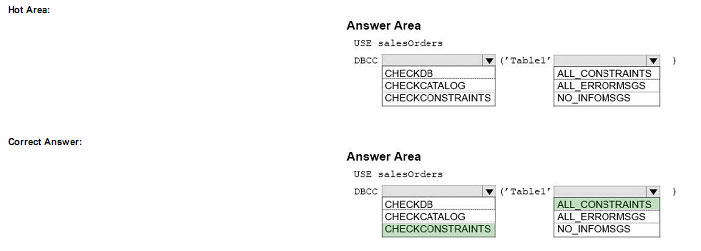
Explanation
Explanation/Reference:
QUESTION 9
HOTSPOT
You use SQL Server 2016. You create a table within a database by using the following DDL:
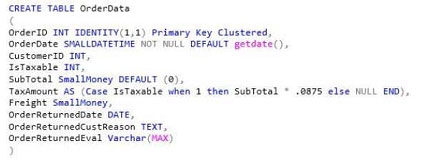
The following table illustrates a representative sample of data
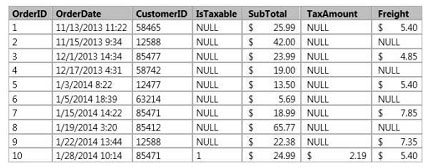
The system is expected to handle 50 million orders a month over the next five years.
You have been instructed by your Team Lead to follow best practices for storage and performance in the utilization of SPARSE columns.
Which columns should you designate as SPARSE? To answer, mark each column as SPARSE or NOT SPARSE in the answer area.
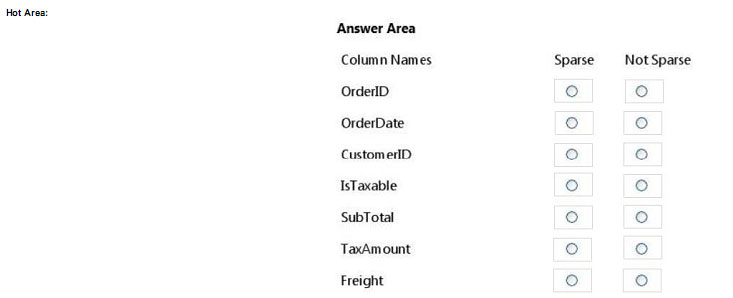
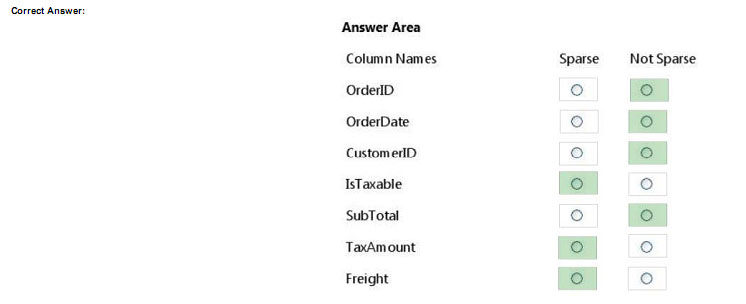
Explanation
Explanation/Reference:
QUESTION 10
DRAG DROP
You are planning to deploy a database to Windows Azure SQL Database.
You need to design a stored procedure to update rows. The stored procedure must meet the following requirements:
If the update fails, an error must be raised to the application and the update must be discarded.
The stored procedure must be designed to maximize concurrency.
What should you include in your design?
To answer, move the appropriate actions from the list of actions to the answer area and arrange them in the correct order
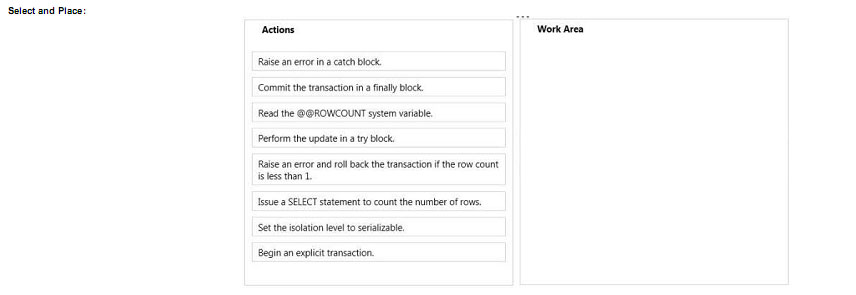
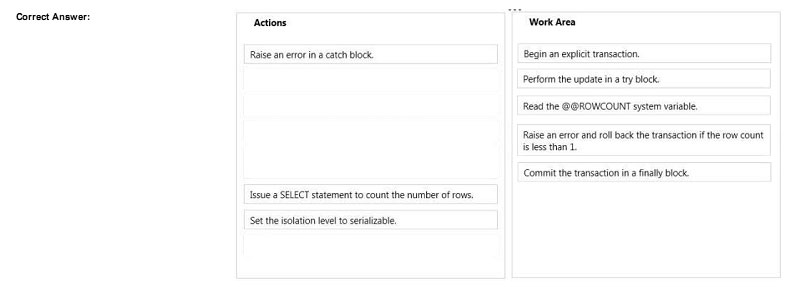
Explanation
Explanation/Reference:
QUESTION 11
DRAG DROP
You have a database named DB1. DB1 contains a table named Sales.SalesPerson that has an index named AK_SalesPerson_rowguid. Queries that do not use the index take approximately 10 times longer to complete than queries that use
the index.
You discover that AK_SalesPerson_rowguid has severe fragmentation.
You need to recommend a solution to defragment the index. The solution must ensure that the index can be used by queries during the defragmentation.
What statement should you use? To answer, drag the appropriate elements to the correct locations. Each element may be used once, more than once, or not at all. You may need to drag the split bar between panes or scroll to view content.
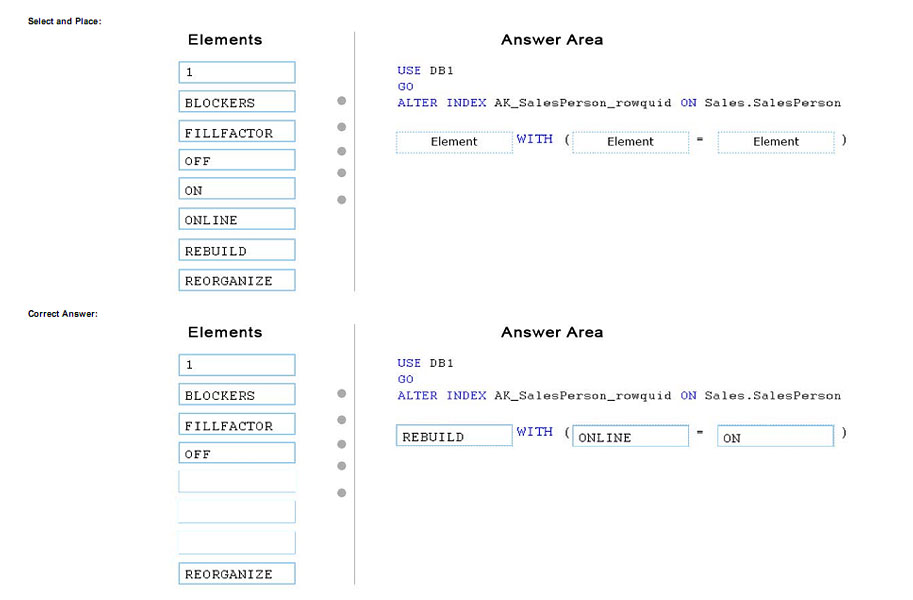
Explanation
Explanation/Reference:
QUESTION 12
HOTSPOT
You manage a Microsoft SQL Server environment. A server fails and writes the following event to the application event log:
MSG_AUDIT_FORCED_SHUTDOWN
You configure the SQL Server startup parameters as shown in the following graphic:
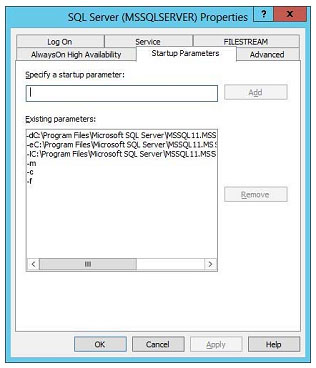
Use the drop-down menus to select the answer choice that answers each question.
NOTE: Each correct selection is worth one point.
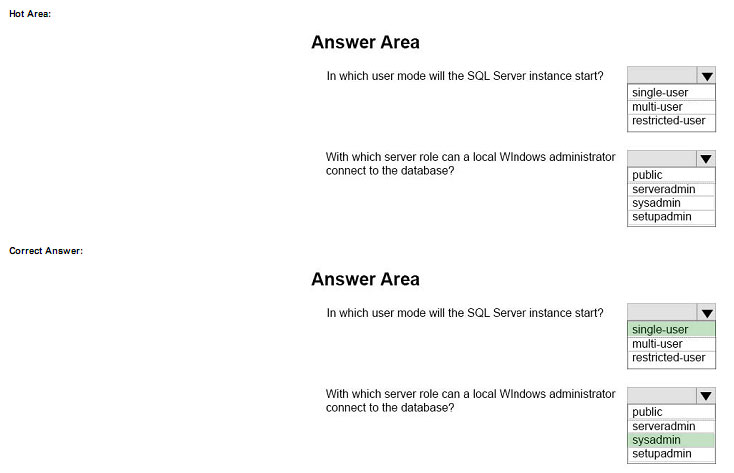
Explanation
Explanation/Reference:
QUESTION 13
DRAG DROP
You are configuring a new Microsoft SQL Server Always On Availability Group. You plan to configure a shared network location at \\DATA-CI1\SQL.
You need to create an availability group listener named AGL1 on port 1433.
In which order should you perform the actions? To answer, move all actions from the list of actions to the answer area and arrange them in the correct order.
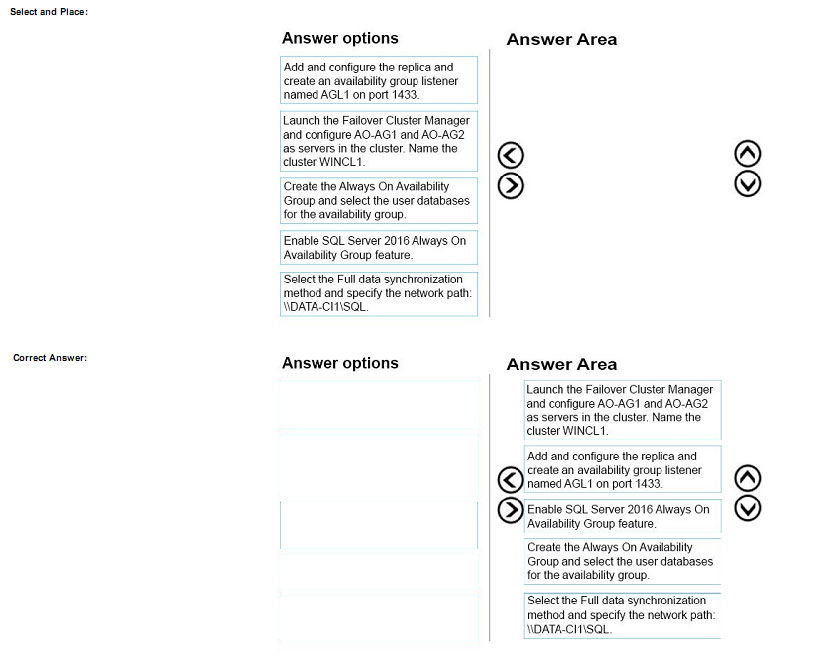
Explanation
Explanation/Reference:
QUESTION 14
DRAG DROP
You plan to deploy a database by using SQL Server 2016.
Your company identifies the following requirements for the database:
The name of all stored procedures must start with “usp_”always.
All distribution statistics must be updated daily.
You need to identify which feature must be used to meet each database requirement.
Which features should you identify?
To answer, drag the appropriate feature to the correct database requirement in the answer area
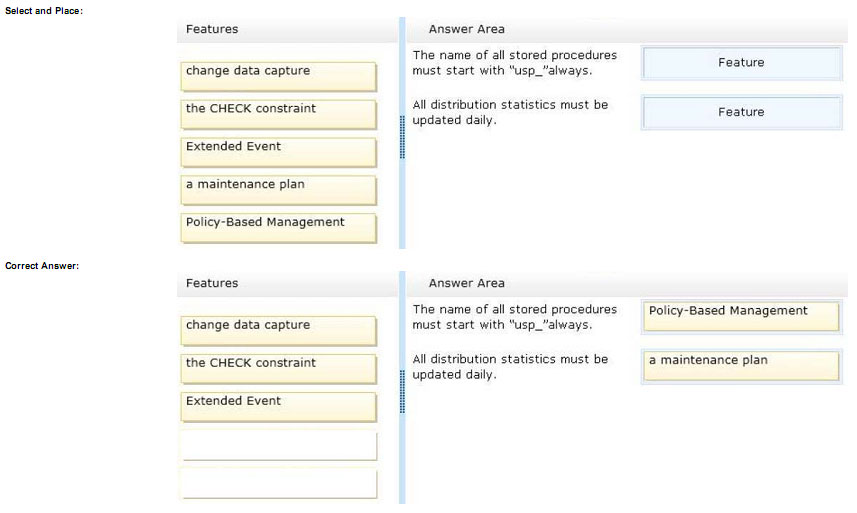
Explanation
Explanation/Reference:
QUESTION 15
DRAG DROP
You have a server named SQL1 that has SQL Server 2016 installed. SQL1 hosts a database named Database! Database1 contains a table named Table1. Table1 is partitioned across five filegroups based on the TransactionType field.
The schema of Table1 is configured as shown in the following table.
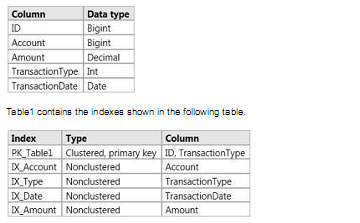
You need to recommend an index strategy to maximize performance for the queries that consume the indexes available to Table1.
Which type of index storage should you recommend?
To answer, drag the appropriate index storage type to the correct index in the answer area.
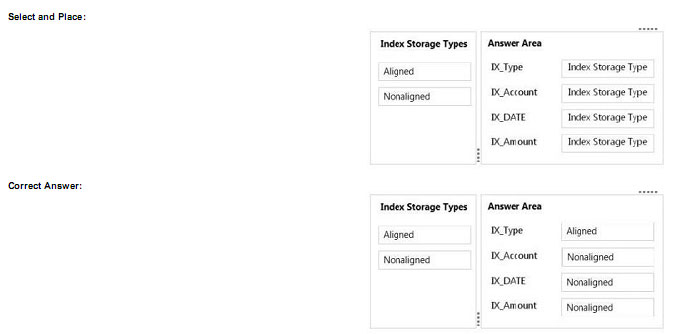
Explanation
Explanation/Reference:
QUESTION 16
DRAG DROP
You have two servers named SQL1 and SQL2 that have SQL Server 2012 installed. SQL1 contains a database that is mirrored asynchronously to SQL2. The database contents are updated once a month.
You need to upgrade the database to SQL Server 2016. The solution must minimize downtime.
Which upgrade steps should you recommend?
To answer, move the appropriate actions from the list of actions to the answer area and arrange them in the correct order.
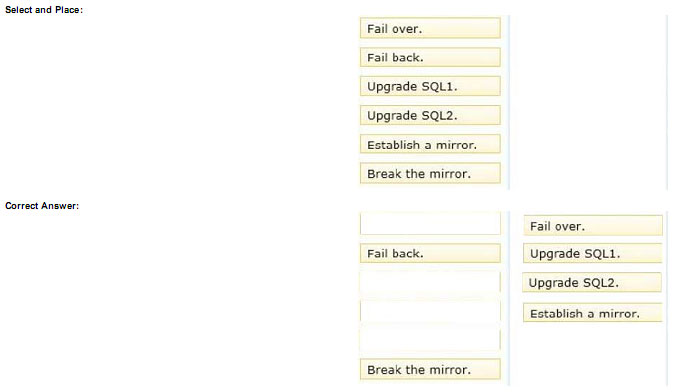
Explanation
Explanation/Reference:
QUESTION 17
DRAG DROP
You plan to deploy three highly available SQL Server environments that will use SQL Server 2016.
You identify the following specifications for each environment as shown following table.

You need to recommend which high-availability feature is required for each environment.
Which features should you identify?
To answer, drag the appropriate feature to the correct requirement in the answer area.
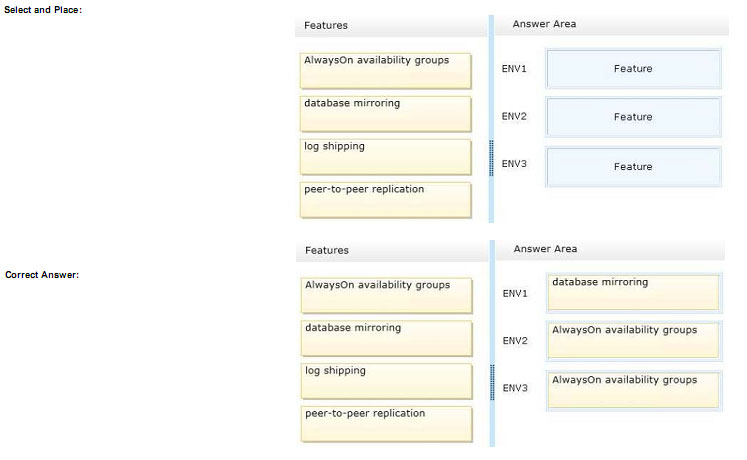
Explanation
Explanation/Reference:
QUESTION 18
HOTSPOT
Note: This question is part of a series of questions that use the same scenario. For your convenience, the scenario is repeated in each question. Each question presents a different goal and answer choices, but the text of the scenario is
exactly the same in each question in this series.
You are a database administrator for a company that has an on-premises Microsoft SQL Server environment and Microsoft Azure SQL Database instances. The environment hosts several customer databases, and each customer uses a
dedicated instance. The environments that you manage are shown in the following table.
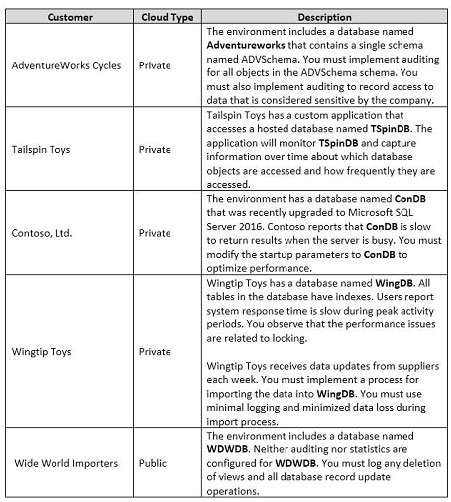
You need to configure auditing for the Adventure Works environment.
How should you complete the Transact-SQL statement? To answer, select the appropriate options in the answer area.
NOTE: Each correct selection is worth one point
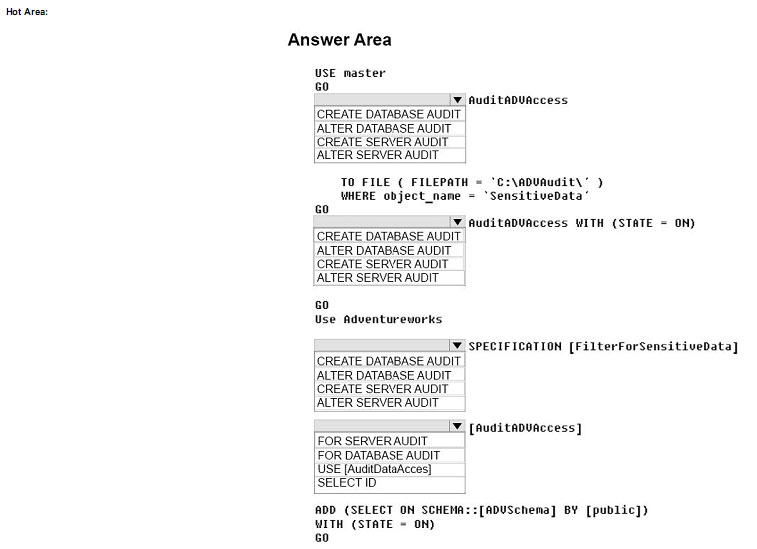
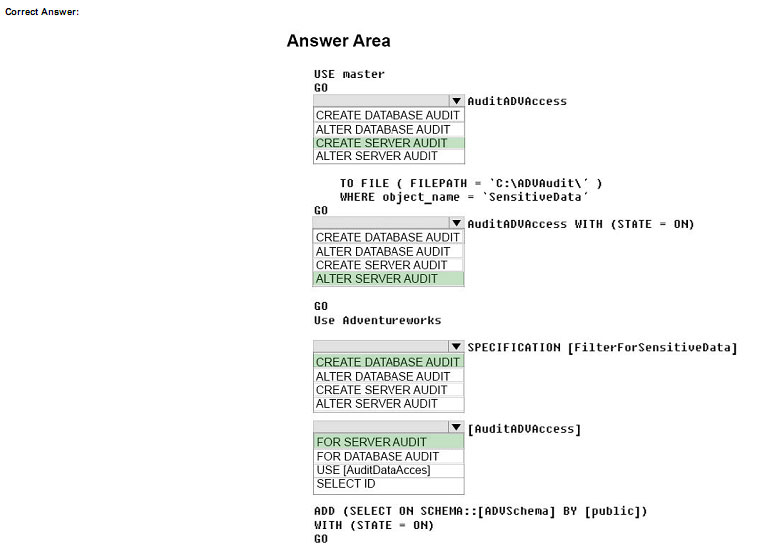
Explanation
Explanation/Reference:
QUESTION 19
HOTSPOT
You are planning the deployment of two new Always On Failover Cluster Instances (FCIs) of Microsoft SQL Server to a single Windows Server Cluster with three nodes. The planned configuration for the cluster is shown in the Server Layout
exhibit. (Click the Exhibit button.)
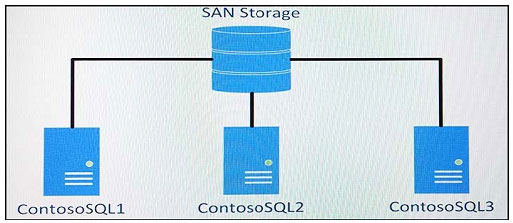
The SAN team has configured storage for the cluster and sent the configuration to you in the email shown in the SAN Team Email exhibit. (Click the Exhibit button.)
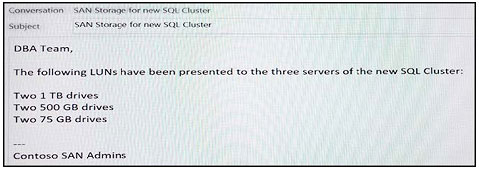
Each node of the cluster has identical local storage available as shown in the Local Storage exhibit. (Click the Exhibit button.)

All local storage is on SSD.
You need to plan specific configurations for the new cluster.
For each of the following statement, select Yes if the statement is true. Otherwise, select No.
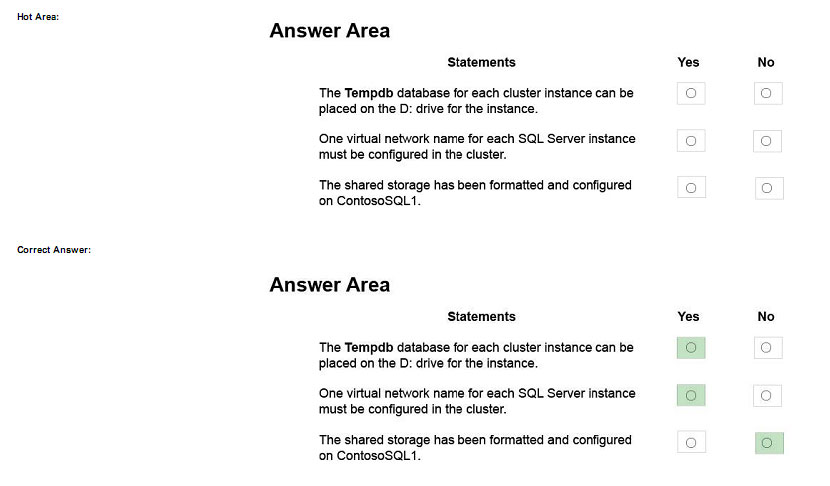
Explanation
Explanation/Reference:
QUESTION 20
HOTSPOT
Note: This question is part of a series of questions that use the same scenario. For your convenience, the scenario is repeated in each question. Each question presents a different goal and answer choices, but the text of the scenario is
exactly the same in each question in this series.
You are a database administrator for a company that has an on-premises Microsoft SQL Server environment and Microsoft Azure SQL Database instances. The environment hosts several customer databases, and each customer uses a
dedicated instance. The environments that you manage are shown in the following table.
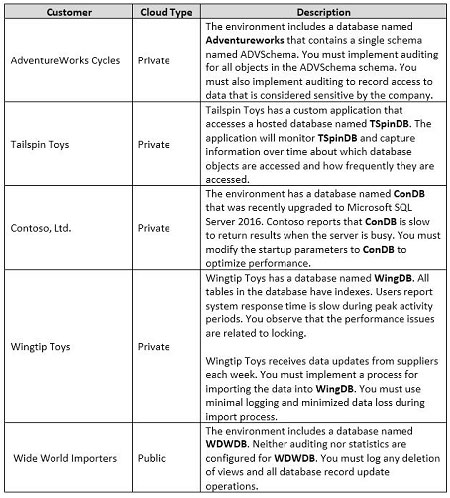
You need to configure the Contoso instance.
How should you complete the Transact-SQL statement? To answer, select the appropriate Transact-SQL segments in the answer area
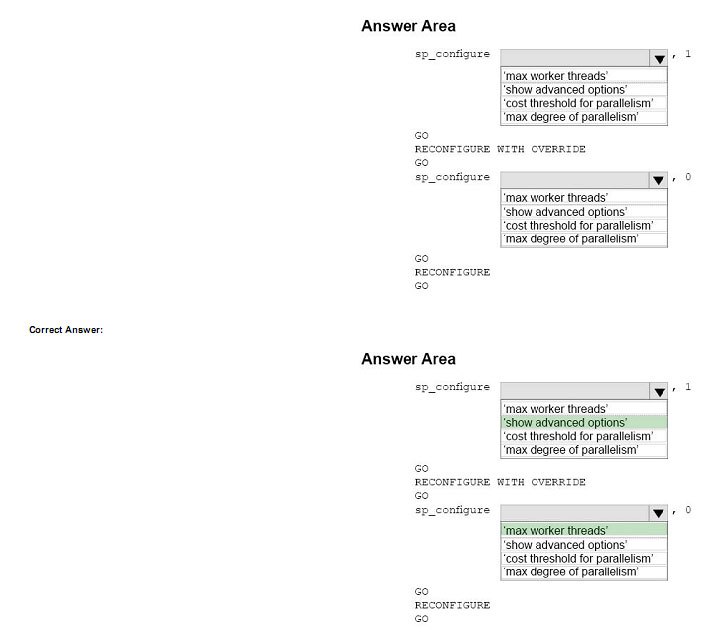
Explanation
Explanation/Reference:
QUESTION 21
HOTSPOT
Note: This question is part of a series of questions that use the same scenario. For your convenience, the scenario is repeated in each question. Each question presents a different goal and answer choices, but the text of the scenario is
exactly the same in each question in this series.
You are a database administrator for a company that has an on-premises Microsoft SQL Server environment and Microsoft Azure SQL Database instances. The environment hosts several customer databases, and each customer uses a
dedicated instance. The environments that you manage are shown in the following table
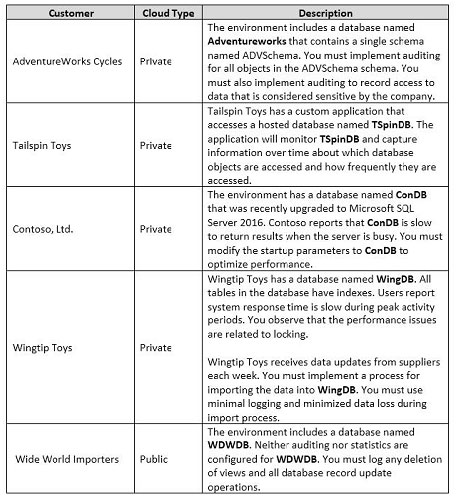
You need to configure auditing for WDWDB.
In the table below, identify the event type that you must audit for each activity
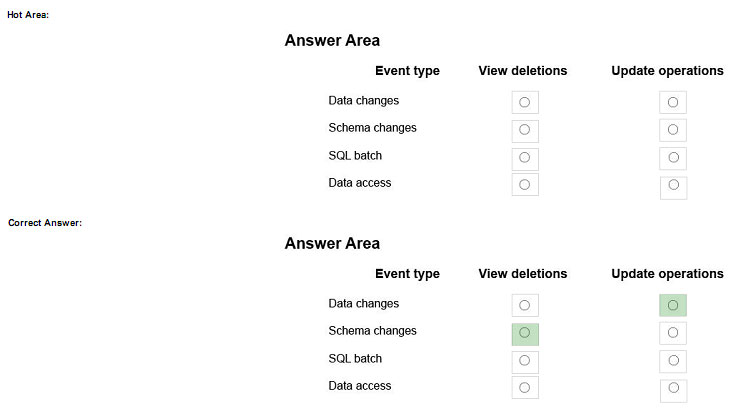
Explanation
Explanation/Reference:
QUESTION 22
HOTSPOT
You are the database administrator of a Microsoft SQL Server instance. Developers are writing stored procedures to send emails using sp_send_dbmail. Database Mail is enabled.
You need to configure each account’s profile security and meet the following requirements:
In the table below. identify the profile type that must be used for each account.
NOTE: Make only one selection in each column.
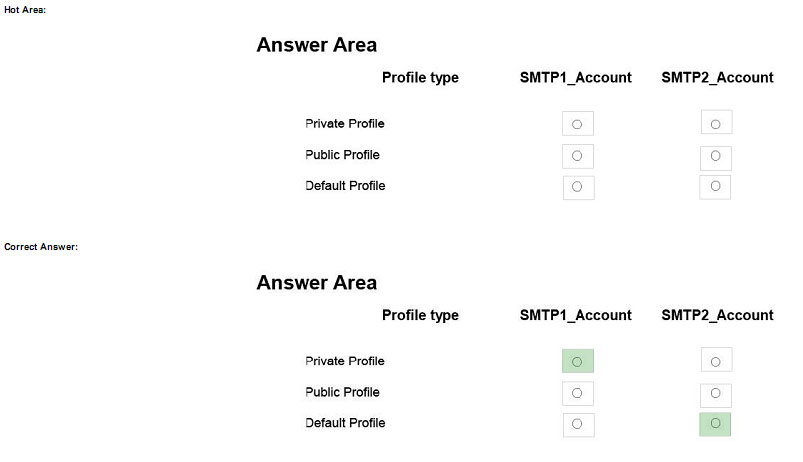
Explanation
Explanation/Reference:
QUESTION 23
DRAG DROP
You need to recommend a backup process for data warehouse database.
The solution must meet the following requirements:
Ensure that if a hardware failure occurs, you can bring the database online without losing more than 24 hours of transactions.
Minimize the amount of administrative effort required to restore any lost data.
Minimize the space used by transaction logs.
What should you include in the recommendation?
To answer, move the appropriate actions from the list of actions to the answer area and arrange them in the correct order
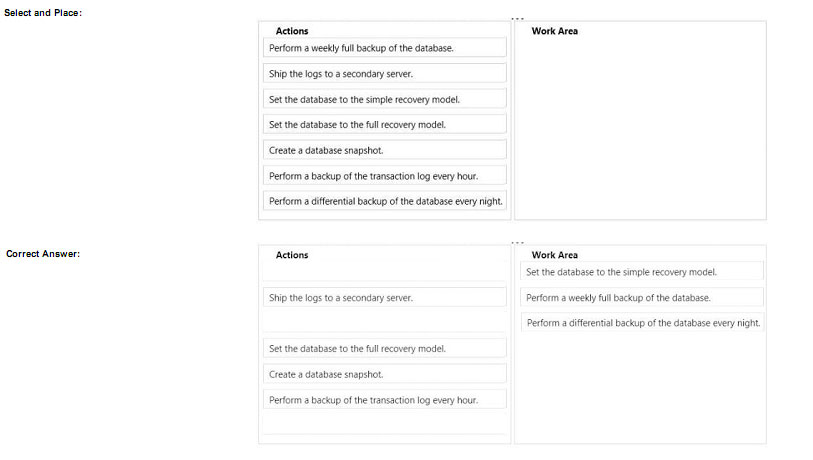
Explanation
Explanation/Reference:
QUESTION 24
DRAG DROP
You are the database administrator for a Microsoft SQL Server instance. You develop an Extended Events package to look for events related to application performance.
You need to change the event session to include SQL Server errors that are greater than error severity 15.
Which five Transact-SQL segments should you use to develop the solution? To answer, move the appropriate Transact-SQL segments from the list of Transact-SQL segments to the answer area and arrange them in the correct order.
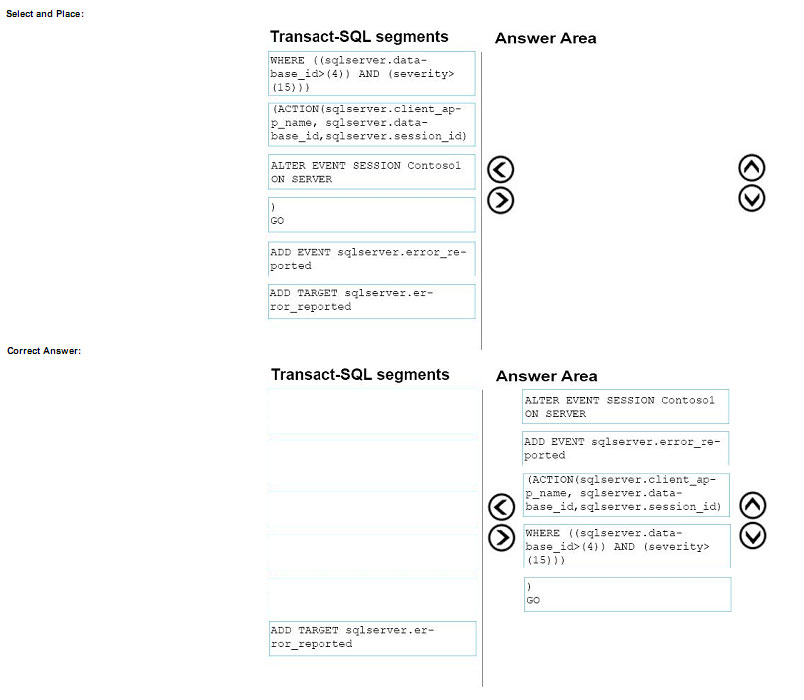
Explanation
Explanation/Reference:
QUESTION 25
DRAG DROP
You have an SQL Server 2016 server.
You plan to create four stored procedures that will use transactions. The stored procedures will be configured as shown in the following table

You need to recommend an isolation level for each stored procedure. The solution must support the concurrency strategy of each stored procedure and must minimize locks.
What should you recommend? To answer, drag the appropriate isolation levels to the correct stored procedures. Each isolation level may be used once, more than once, or not at all. You may need to drag the split bar between panes or scroll
to view content.
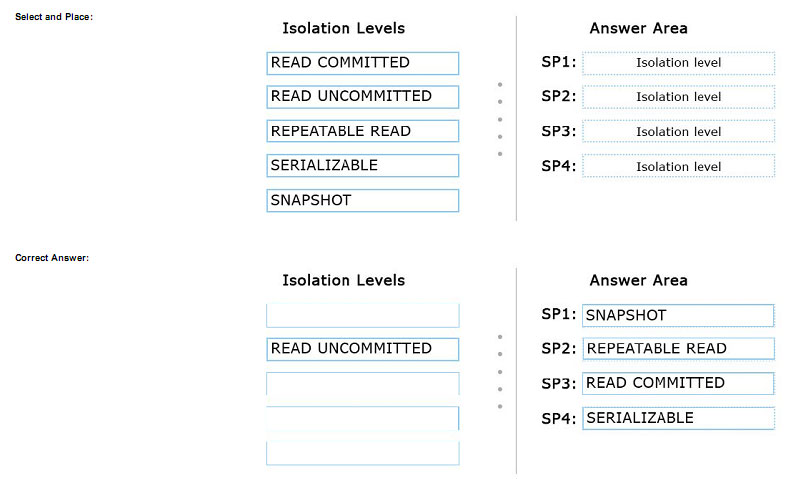
Explanation
Explanation/Reference:
QUESTION 26
DRAG DROP
Note: This question is part of a series of questions that use the same scenario. For your convenience, the scenario is repeated in each question. Each question presents a different goal and answer choices, but the text of the scenario is
exactly the same in each question in this series.
You are a database administrator for a company that has an on-premises Microsoft SQL Server environment and Microsoft Azure SQL Database instances. The environment hosts several customer databases, and each customer uses a
dedicated instance. The environments that you manage are shown in the following table
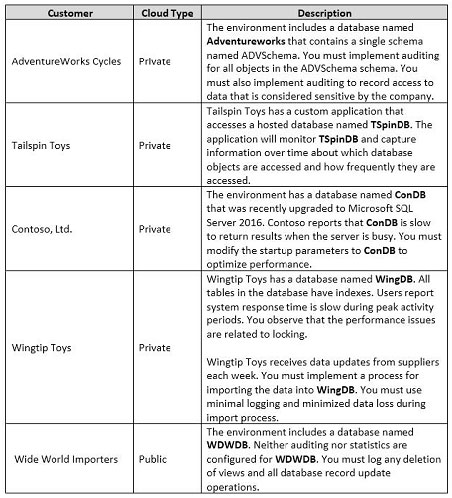
You need to implement a process for importing data into WingDB.
Which three actions should you perform in sequence? To answer, move the appropriate actions from the list of actions to the answer area and arrange them in the correct order
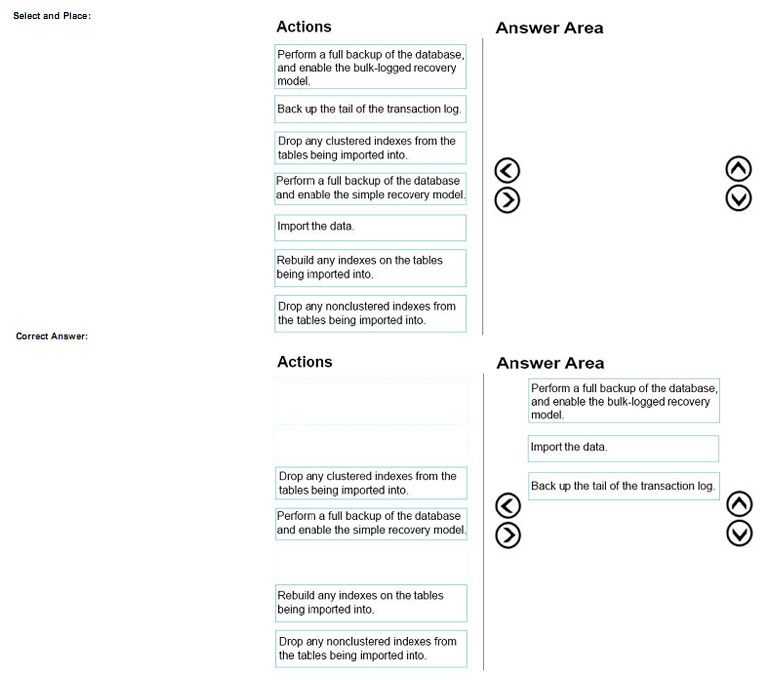
Explanation
Explanation/Reference:
QUESTION 27
HOTSPOT
You are planning to deploy log shipping for Microsoft SQL Server and store all backups on a dedicated fileshare.
You need to configure the servers to perform each log shipping step.
Which server instance should you configure to perform each action? To answer, select the appropriate server instances in the dialog box in the answer area
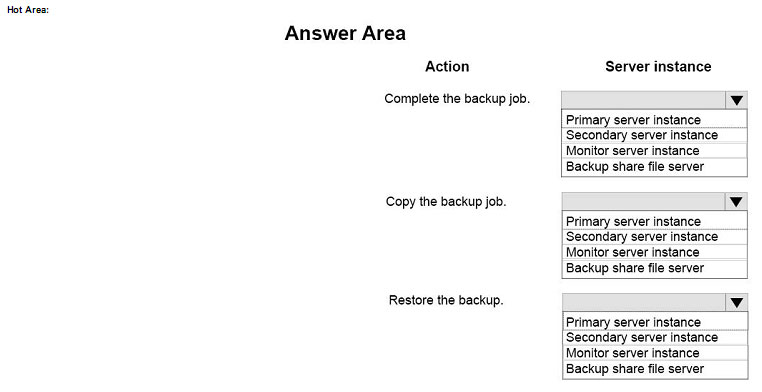
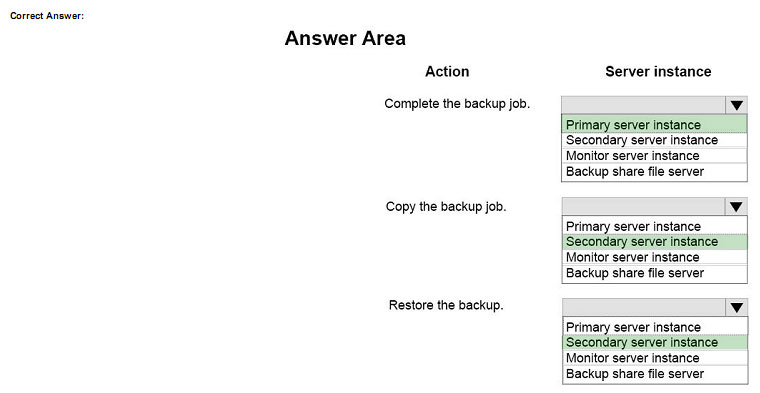
Explanation
Explanation/Reference:
QUESTION 28
HOTSPOT
You manage a Microsoft-SQL Server database named sales Orders.
You need to verify the integrity of the database and attempt to repair any errors that are found. Repair must not cause any data to be lost in the database.
How should you complete the DBCC command? To answer, select the appropriate options in the answer area.
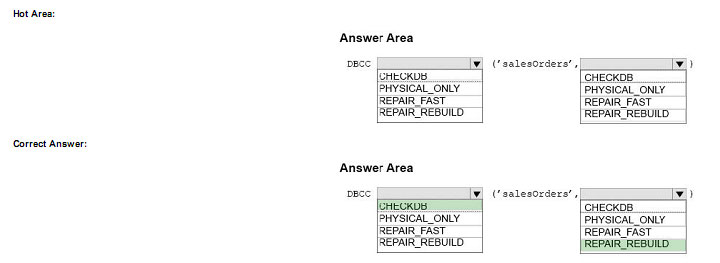
Explanation
Explanation/Reference:
QUESTION 29
HOTSPOT
Note: This question is part of a series of questions that use the same scenario. For your convenience, the scenario is repeated in each question. Each question presents a different goal and answer choices, but the text of the scenario is
exactly the same in each question in this series.
You have five servers that run Microsoft Windows 2012 R2. Each server hosts a Microsoft SQL Server instance. The topology for the environment is shown in the following diagram.
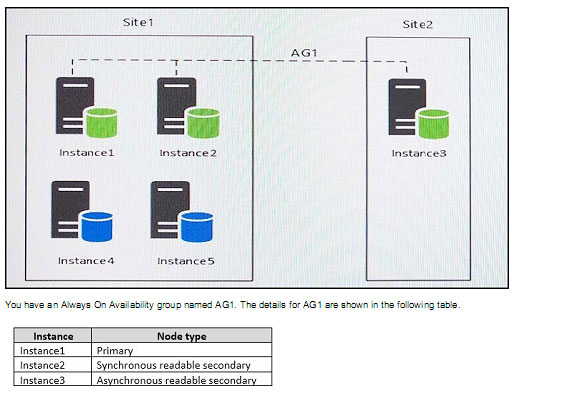
Instance1 experiences heavy read-write traffic. The instance hosts a database named OperationsMain that is four terabytes (TB) in size. The database has multiple data files and filegroups. One of the filegroups is read_only and is half of the
total database size.
Instance4 and Instance5 are not part of AG1. Instance4 is engaged in heavy read-write I/O.
Instance5 hosts a database named StagedExternal. A nightly BULK INSERT process loads data into an empty table that has a rowstore clustered index and two nonclustered rowstore indexes.
You must minimize the growth of the StagedExternal database log file during the BULK INSERT operations and perform point-in-time recovery after the BULK INSERT transaction.
Changes made must not interrupt the log backup chain.
You plan to add a new instance named Instance6 to a datacenter that is geographically distant from Site1 and Site2. You must minimize latency between the nodes in AG1.
All databases use the full recovery model. All backups are written to the network location \\SQLBackup\. A separate process copies backups to an offsite location. You should minimize both the time required to restore the databases and the
space required to store backups. The recovery point objective (RPO) for each instance is shown in the following table
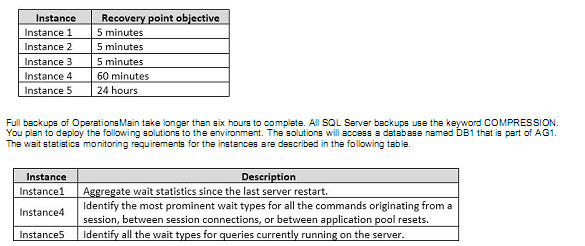
You need to create the connection strings for the operations and reporting systems.
In the table below, identify the option that must be specified in each connection string.
NOTE: Make only one selection in each column.
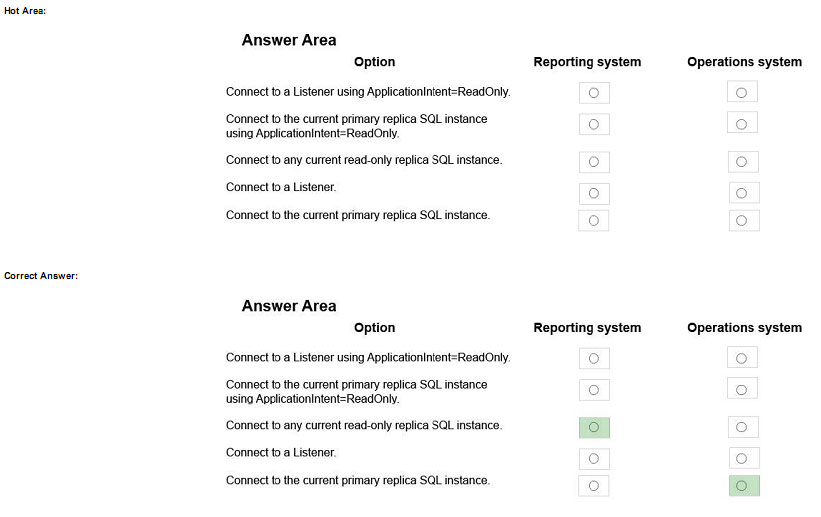
Explanation
Explanation/Reference:
QUESTION 30
HOTSPOT
You deploy a Microsoft SQL Server instance to support a global sales application. The instance includes the following tables: TableA and TableB.
TableA is a partitioned table that uses an incrementing integer number for partitioning. The table has millions of rows in each partition. Most changes to the data in TableA affect recently added data. The UPDATE STATISTICS for TableA
takes longer to complete than the allotted maintenance window.
Thousands of operations are performed against TableB each minute. You observe a large number of Auto Update Statistics events for TableB.
You need to address the performance issues with each table.
In the table below, identify the action that will resolve the issues for each table.
NOTE: Make only one selection in each column.
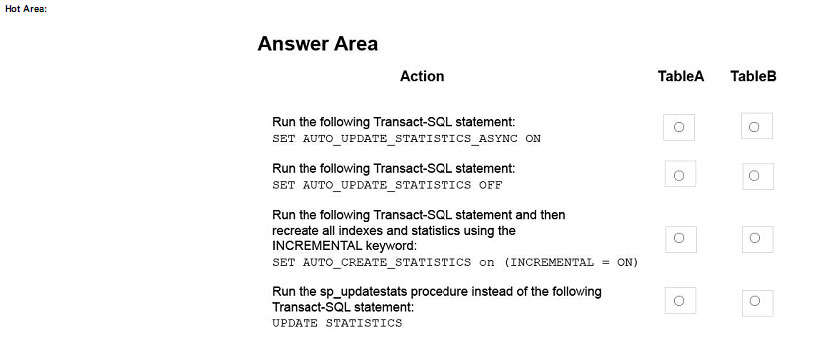
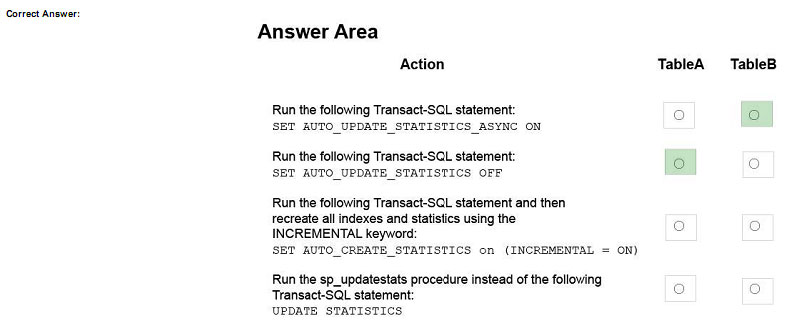
Conclusion:
Welcome here, above we provide free Microsoft MCSA 70-764 exam dumps and 70-764 PDF. I believe it must be very helpful to you,
free content can only help you to open the first step of learning.
If you want to pass Microsoft MCSA 70-764 for your first exam, select: Pass4itsure 70-764 PDF + 70-764 VCE mode.
100% effective, easy to pass the 70-764 exam: https://www.pass4itsure.com/70-764.html
[PDF] Free Microsoft MCSA 70-764 dumps download from Google Drive:
https://drive.google.com/open?id=1tIorh0jIgCtjseDYvUcvRopg6sXZ17fq
[PDF] Free Full Microsoft MCSA dumps download from Google Drive:
https://drive.google.com/open?id=1VBDzuasBbmByXUKyUaZejR3hFzTke722
Pass4itsure Promo Code 15% Off
related: http://www.downloadzpdf.com/100-pass-1y0-201-dumps-citrix-xendesktop-exam/

